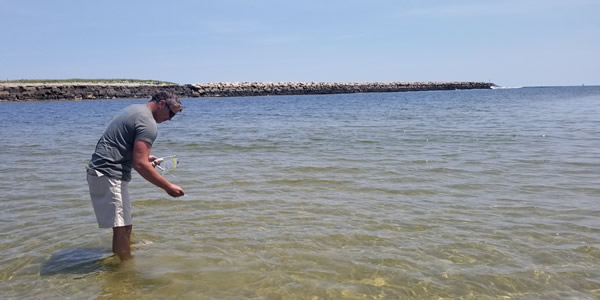Home → Water Quality → Healthy Beaches → Monitoring, Notifications, Illness
Monitoring, Notifications, and Illness

The MHB program is voluntary and is not mandated by Maine State law. Monitoring coastal water quality for swimming and other water contact is the responsibility of local jurisdictions. EPA funding supports monitoring of moderate to high use beaches with adequate public access. New beaches are recruited over time as interest, resources, and funding allows and/or circumstances change town/state park eligibility for program participation.
Monitoring
The MHB program coordinates routine monitoring of coastal saltwater beaches from Memorial Day to Labor Day using EPA-approved quality assured protocols. The MHB program only monitors saltwater beaches; for information about freshwater beaches, see Freshwater Beach Information.
The water samples collected at participating beaches are sent to a local laboratory for analysis. Results are typically available the following day and are posted to the MHB website under Check Beach Status.
Fecal indicator bacteria (FIB) are bacteria associated with the fecal material of humans and other warm-blooded animals. MHB monitors for the FIB Enterococcus. Fecal indicator bacteria are used to indicate the possible presence of pathogens (disease causing organisms) in the environment. There are far too many pathogens to test for individually, so FIB are used instead. The indicator bacteria themselves might not make someone sick, but their presence suggests that pathogens may also be present, and these pathogens could make someone sick.
To help evaluate if a swim beach is safe for swimming, EPA has developed a Beach Action Value (BAV) for indicator bacteria to use as a threshold for when to issue Elevated Bacteria advisories. Maine's EPA-approved Beach Action Value (or single sample maximum safety threshold) for Enterococci in marine waters is 104 MPN/100 mL (most probable number of Enterococci bacteria per 100 milliliters of sample water).
Please see DEP's recommendations for monitoring at freshwater beaches.
Notifications
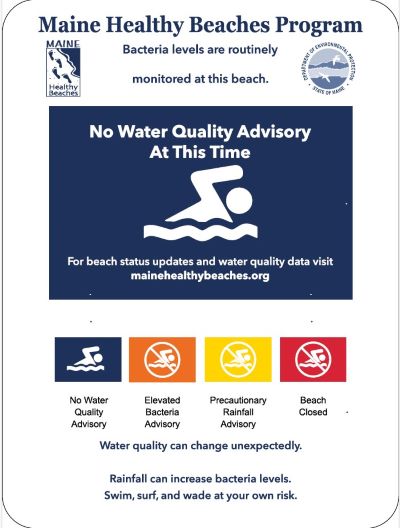
Local beach managers use MHB data to make informed management decisions in support of protecting public health, including issuing public notifications of advisories and closures at participating beaches. Beach managers communicate these notification decisions to the public through the MHB website and by posting signage at beaches. Advisories are issued as a recommendation to the public to avoid water contact activities in areas where bacteria results have exceeded the BAV and the risk for water-related illness is greater. It is recommended that the public avoid all water contact activities at those locations when an advisory is issued. Illness can result from ingesting contaminated water while swimming; getting water in the nose, eyes, or ears; or entry through an open wound.
To view current or past advisories and closures visit the Check Beach Status page.
Following an exceedance, the participating town/state park will, in most cases, issue an advisory and collect another sample at the beach. Once a follow-up sample demonstrates that the concentration of bacteria is below the safety threshold, advisory signs are removed from the beach and advisories are taken down from the website.
In Maine, beach advisories can be either Elevated Bacteria advisories or Precautionary Rainfall advisories. These advisories are recommendations to the public to avoid water contact activities at the beach until analyses indicate safe conditions. Elevated Bacteria advisories are issued due to elevated bacteria results, i.e. an Enterococcus result above the BAV. Moderate to heavy rainfall is often associated with an increased risk of bacterial contamination at the beach. To mitigate risks to public health, Precautionary Rainfall advisories are issued pre-emptively based on local precipitation (typically following 1 or more inches of rainfall in a 24-hour period). A decision to post an advisory or closure at a beach is also based upon a beach's Risk Assessment Matrix, a tool beach managers use for ongoing management decisions.
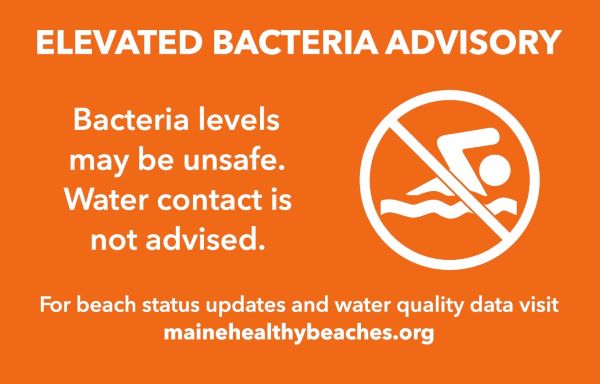
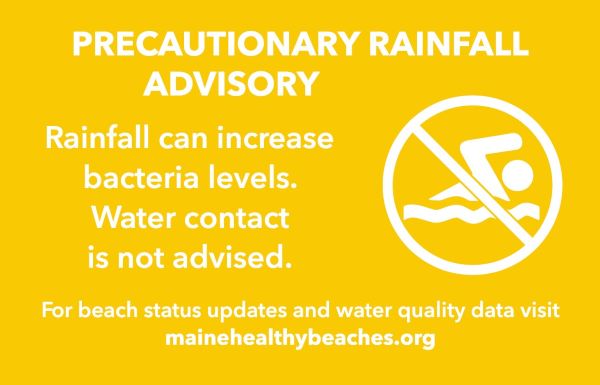
A beach closure is more severe than an advisory. While it is rare to have closures in Maine, they do occur. A municipality must have a specific ordinance in place to close a beach. A closure includes the ability to keep people out of the water or close the beach to usage. Beaches are not closed as a result of a single exceedance of Maine's safety threshold. Closures are determined by a number of potential factors and are often based on a known contamination event or chronic, unsafe conditions related to elevated bacteria concentrations. A beach may be closed as a result of, but not limited to, the following: sewage treatment plant malfunctions, severe flooding, rip currents, sharks, hazardous surf conditions, and other safety hazards.
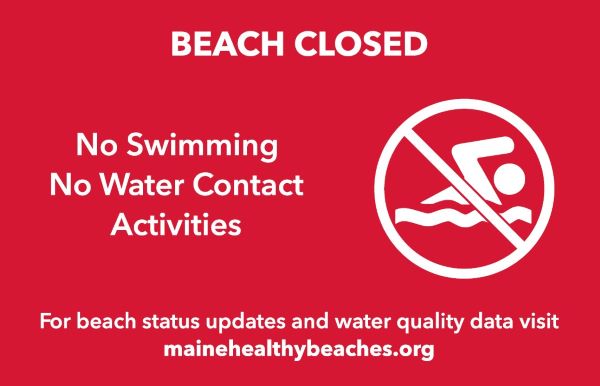
To view current beach advisories for participating coastal beaches, check the beach status.
Illness
What kind of illnesses can someone get from contaminated beach water?
The most commonly reported recreational water illnesses are gastrointestinal, respiratory, or skin related. These can be caused by bacteria, parasites and viruses such as Cryptosporidium, Giardia, Shigella, and E. coli. For more information about these bacteria and parasites, see the CDC Healthy Swimming website.
What are the symptoms of a recreational waterborne illness (RWI)?
Nausea, diarrhea, stomach cramps, chills, fever, sinus infections, and other flu-like symptoms can be caused by contact with contaminated water. Other illnesses can include skin rashes and infections of the eyes, ears, nose, and throat. If you experience any of these symptoms, contact your physician and report any recreational, water-derived illnesses to the Maine Center for Disease Control and Prevention.
How are recreational waterborne illnesses contracted?
RWIs may be contracted by swallowing or having contact with contaminated water (freshwater or saltwater). The water can become contaminated by fecal matter which carries harmful bacteria, parasites, and viruses. These unsanitary conditions can be a result of several possible sources:
- Improperly disposed of diapers
- Children not properly cleaned after using the bathroom
- Swimmers with diarrhea
- A vomiting or fecal accident in the water
- Waste from wildlife, domestic animals, and pets
- Malfunctioning subsurface wastewater disposal (septic) or sanitary collection (sewage treatment plant) systems
- Boats discharging sewage into the water
- Contaminated stormwater runoff
